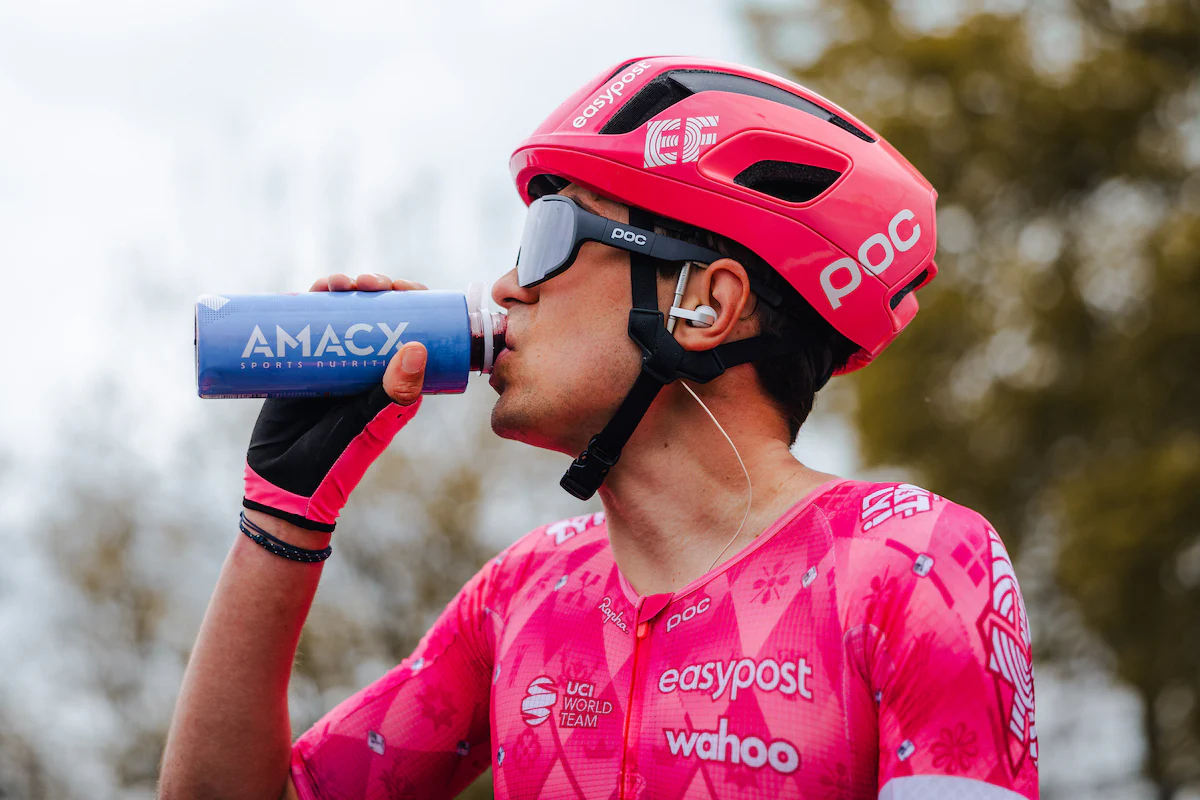Tour de France cyclists keep drinking cherry juice at the finish line, here's why
We explain the mysterious red liquid being drunk by riders at the finish line

In a race as brutal as the Tour de France, which spans three arduous weeks, recovery plays a huge role in day to day performance, so teams are continuously searching for ways to stay fresh and recover more quickly between stages.
One increasingly popular solution in that recovery arsenal is tart cherry juice, made from Montmorency cherries. At the end of stages when we see teams such as Soudal Quick‑Step and EF Education‑EasyPost necking a bottle of dark red liquid, it's cherry juice.
The anti‑inflammatory effect
Tart cherries are packed with an antioxidant compound called anthocyanins, which gives them their deep red hue. These compounds reduce oxidative stress and inflammation in muscles following hard efforts.
A meta‑analysis of the scientific literature around tart cherry supplementation carried out in 2020 found that it significantly reduced indicators of muscle soreness, inflammation and strength loss after exercise. Another review from 2017 confirmed that for endurance athletes, such as WorldTour cyclists, cherry juice led to less muscle pain and better maintenance of function.
This is invaluable in races like the Tour de France, where there is little opportunity for extended rest. Riders regularly cross the line after a punishing day and have 18 hours or less before having to go again.
Fueling recovery with carbs and more
Tart cherry juice not only offers anti‑inflammatory benefits but also provides a useful carbohydrate boost. A 240ml serving typically contains around 30 to 35 grams of carbs.
Some teams mix it into a recovery drink combined with protein, electrolytes, and often more carbs, and this helps to tackle all aspects of recovery as soon as possible after the stage.
The latest race content, interviews, features, reviews and expert buying guides, direct to your inbox!
This timely refuelling is essential when riders have to be ready for another day’s racing so soon after the last one is finished, as any missed opportunity to feed tends not to be able to be caught up on in the future. That can then bite back hard several stages down the line.
A natural sleep aid
Tour de France life is more than physical strain. Riders contend with disrupted routines, travel between towns, hotel changes, and the mental intensity of the race. As a result, sleep quality can suffer.
Cherry juice naturally contains melatonin and the amino acid tryptophan, both of which can contribute to more restful sleep. Studies have shown a clear benefit for sleep duration and quality in adults consuming Montmorency cherry juice.
Better rest supports hormonal balance and repair mechanisms, which is critical when trying to perform day after day.

How the pros use it
Teams like UAE Team Emirates, Visma-Lease a Bike, EF Education‑EasyPost and Soudal-QuickStep now include cherry juice in their day‑to‑day routines during grand tours. Riders typically begin a pre‑loading phase a few days before the start of a race. This means consuming cherry juice twice a day, usually 240 to 360 millilitres each time, for three to seven days prior to the event.
Once racing begins, the post-stage drink is followed by another serving in the evening to aid sleep.
Most teams favour convenient formats such as concentrated liquids or individual sachets, which stay fresh and travel well. In combination with massages, optimised nutrition and hydration protocols, the strategy supports sustained performance over hard multi‑week events.
Drawbacks to note
Cherry juice is not a cure‑all and there are a few caveats. Some science suggests that using strong antioxidants over long periods can blunt training adaptations, specifically mitochondrial efficiency.
In general training, several adaptations occur as a result of the increased presence of oxidative stress, free radicals (unstable molecules) and hydrogen ions (H+) that all contribute to muscle damage and inflammation.
Present chronically and in a large amount they are bad, hence the antioxidant drink to neutralize them, but in the right amount with adequate rest, they are essential for training adaptations.
Using this knowledge, cherry juice is most useful during peak competition periods such as grand tours, rather than as an everyday training supplement. It has been shown to benefit across multiple recovery pathways; inflammation reduction, glycogen resynthesis and sleep enhancement. This means riders can manage race fatigue better, feel less strained, and wake up in a better shape to tackle another day’s challenge.
Cost is another practical concern. Quality tart cherry products can be expensive, but at the WorldTour level that’s not so much of a consideration, and they are better value than ketones.
Summary
Cherry juice is more than a fad. Its combination of anti‑inflammatory antioxidants, carbohydrates, and sleep‑supporting compounds makes it a smart pick for Tour de France riders.
With pre‑loading and consistent use during competition, it helps protect riders from the cumulative strain of back-to-back severe efforts. It is not a miracle potion, but treated thoughtfully and used at the right time, it has earned its place in the pro peloton’s recovery playbook.

Freelance cycling journalist Andy Turner is a fully qualified sports scientist, cycling coach at ATP Performance, and aerodynamics consultant at Venturi Dynamics. He also spent 3 years racing as a UCI Continental professional and held a British Cycling Elite Race Licence for 7 years. He now enjoys writing fitness and tech related articles, and putting cycling products through their paces for reviews. Predominantly road focussed, he is slowly venturing into the world of gravel too, as many ‘retired’ UCI riders do.
When it comes to cycling equipment, he looks for functionality, a little bit of bling, and ideally aero gains. Style and tradition are secondary, performance is key.
He has raced the Tour of Britain and Volta a Portugal, but nowadays spends his time on the other side of races in the convoy as a DS, coaching riders to race wins themselves, and limiting his riding to Strava hunting, big adventures, and café rides.
You must confirm your public display name before commenting
Please logout and then login again, you will then be prompted to enter your display name.